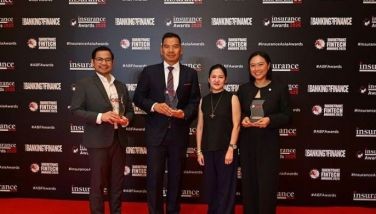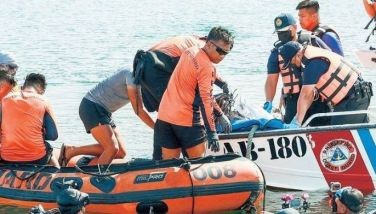Aiming high? Try the sky!
MANILA, Philippines - Home is where the heart is, supposedly. And the country is counting on its best sons and daughters – the ones who found the proverbial greener pastures in America and beyond – to find their way back home, and when they do, to help in the nation’s struggling efforts at development and progress.
The global diaspora has a secret facet. Ask the 10 million Filipinos now living and working abroad – one doesn’t really leave “permanently for good.” The nomads of the world habitually sneak in and out of their places of birth in varying rituals seeking rootedness.
In one of these “sneaks in,” a Filipino US Air Force pilot was strolling around downtown Manila when he stumbled on his old school and an accidental advocacy that he now embraces with full passion.
The school was Feati University in the Quiapo area, where Charles “Chuck” Castro graduated in 1966 with a degree in Aeronautical Engineering. This was the same Feati that Castro remembered, the one whose building facade had these words emblazoned at the top: “Look Up, Young Man, Look Up.”
And the first thing that Castro did when he discovered that he was “home” was to look up, and yes, the sign is still there.
Now, things are “looking up” for Feati University. One of its most famous alumni has returned home to help reinvigorate its aeronautical program, one of the very first programs introduced when the school was founded in 1946.
As Castro recounted to STARweek over dinner, he “went inside, asked to be brought to his old college, introduced himself as a US Air Force pilot and an alumni of the school.” Not quite believing what they heard, the school personnel looked for the school annual to check his name on the list of graduates. The dean and other school officials were notified and what followed was hours of discussion, with Castro recounting his experiences flying and testing fighter jets.
The school has a reason to fuss. Castro is no ordinary American military pilot; he was the United States Air Force’s chief systems engineer and program manager. He has been assigned to the F-16 Fighter Aircraft Program Office where he led its development, including the integration of aircraft avionics systems, inertial navigation systems and global positioning systems (GPS) and overall avionics suite. He is certified in three academic and professional disciplines – developmental engineering, weapons acquisition program management and developmental test and evaluation.
In 1995, he was named one of the 20 Outstanding Filipinos in the US and Canada, and in 2006, he was honored with the Panday Pira Award for Engineering. In 2007, he was inducted into the Filipino-American Hall of Fame for Engineering and Community Leadership in Chicago.
In February this year, he was back in the country as a Balik Scientist of the Department of Science and Technology (DOST) and spent eight weeks touring the country, giving lectures to graduating high school students, speaking at commencement exercises and encouraging young people to consider a career in aeronautics, a course that has long been in limbo and needs “massive resuscitation.”
The students were very enthusiastic and the response of his audience everywhere in the country was overwhelming. “Some students even consulted with me after the talks to learn more about flying and the possibilities of pursuing aeronautics as a career,” he shares.
But what is the future of aeronautics graduates in a country that does not have a well-developed industry to take them in after graduation?
“That requires a long-term solution,” Castro says emphatically. “The academe, the government, and the industry must come together to build that future. If other countries can do it, we can also do it.”
During his eight-week stay in the country, Castro has also led roundtable discussions with these three sectors to lay down the strategy.
Currently, he says the aeronautics industry in the country is limited to the repair and maintenance of commercial aircraft. But this should not be the case because the Philippines is strategically located in the Pacific basin and could be the ideal site for aircraft refueling, for the manufacture of landing gears, GPS boxes and other navigation devices and spare parts, for the development of software related to the aerospace industry, and for training commercial, military and test pilots.
“Aircraft or aeronautics technology,” he shares, “is software-laden,” and Castro believes that Filipinos can very well do this job given the right training and opportunity.
The area where he can help most, of course, is the academe – at Feati University in particular – where he has embarked on an extensive program to create a powerful curriculum designed to meet the needs of the aeronautics industry of the future.
“We need to introduce new subjects, improve our existing curriculum, focus on high-speed aerodynamics, systems engineering, aircraft accident navigation and other vital subjects, to name only a few. This we can do over time,” he says, admitting that it will take years to put everything in place.
As far as the government is concerned, Castro says he sees a lot of hope with the effort, in particular, of the DOST to bring back experts and scientists like him to inspire young people and steer the industry in the right direction.
The DOST defines a Balik Scientist like Castro as “a science and technology expert who is a Filipino citizen or a foreigner of Filipino descent, residing abroad and contracted by the government to return and work in the Philippines along his/her field of expertise.”
As for the industry, one way to lure business to invest in the country is to “go and talk business, not science.”
Is there going to be a return on investment? Is it going to be sustainable? Can this country supply the industry with highly skilled workers necessary to sustain growth? These are the questions that industry players will ask, Castro says, before they can commit to invest.
“Do we develop the curriculum and train people first or do we develop the industry first then train people? It’s a chicken-and-egg thing. It’s a complex situation,” he says.
Castro believes though that nothing is impossible, as his life story attests. Having worked for three decades with the top brass of the US military, side by side with graduates of the world’s top aeronautics schools, he says, “I struggled and persevered.”
That he experienced discrimination and other setbacks on his way to the top is an understatement, he says.
While giving an orientation lecture on a pre-flight mission, he recounts that one of his colleagues suddenly asked: “Hey, Chuck, where did you come from?” The crowd broke into a laugh. He says he calmly answered: The Philippines. “Where is that?” was the follow-up question and more laughter.
“Oh, come on, you are a navigator, you know where ‘that’ is,” he says he answered nonchalantly. “Where did you graduate?” asked another, to which he simply answered: “Feati University” and there was another uproar from the crowd.
He credits his school and his military training for this tenacity of spirit and never-say-die attitude.
Before he joined the US Air Force (USAF) in 1978, he served the Armed Forces of the Philippines as an Army company commander of the First Engineer Combat Battalion stationed at Fort Magsaysay in Nueva Ecija. This was followed by a stint at the Philippine Army’s Special Forces (Airborne). He experienced combat action in Central Luzon and later transferred to the Air Force, and graduated from its flying school in 1971.
In the USAF, he served in various flight crew capacities to include C-130 operations in the Central and Southern Americas. He also served in the Illinois Air National Guard, KC-135 Tankers, at the height of the Cold War.
He now says that the nationwide lecture tour as a ‘Balik Scientist’ has opened his eyes to the things he can do to help his country. However, just as he thought he was going to devote his retirement years full time in building the aeronautics program of his alma mater and the aerospace industry in the country, he recently got a call back from USAF.
As of this writing, Castro has rejoined the US military as a flight test pilot for a military aircraft that is yet to be launched. He, however, gave assurances before he left that distance notwithstanding, he will remain as the guiding voice of the program he started here in February.
“Through e-mail, chat, and other forms of connectivity, I will remain in touch with Feati, DOST and the various industry representatives I had the opportunity of meeting while I was here,” he says.
“Call me if there is anything I can do,” he says as he handed out his card.
- Latest
- Trending




















